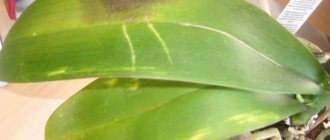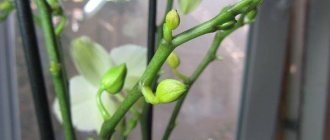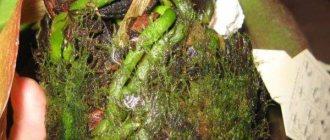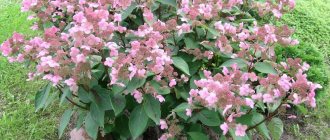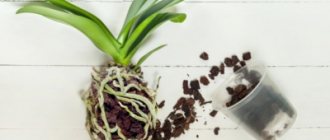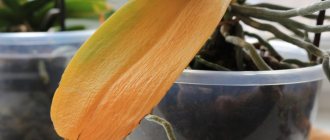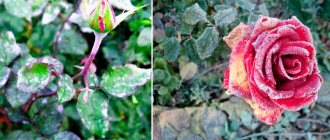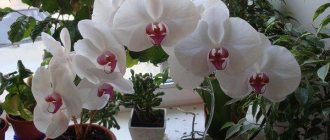How to understand why sticky drops appear and what to do
Drops and spots on the leaf blades warn orchid growers that their “pets” have problems, and force them to look for an answer to the question, when there are sticky drops on the orchid leaves, what to do.
What is transpiration
Transpiration is the evaporation of liquid through leaves, flowers, and stems. Droplets and white coating can spread over a large surface area of the leaves. They attract pollinating insects or pests.
Important! Sticky drops on orchids often do not pose a danger to the flower, as they form for natural reasons. They are washed off with water or washed with a soft cloth.
But often sticky leaves on orchids are signs of improper maintenance or disease. Then it is important to determine in time why they are formed.
Excessive watering
When overflowing, liquid accumulates near the surface layer of the substrate or remains in the pan. The situation can be aggravated by excessive brightness of lighting and inappropriate ambient temperature. If droplets appear on the leaves of the orchid, you need to perform the following steps:
- Move the container with the plant to a place where there is no direct sunlight.
- Dry the substrate.
- Add a drainage layer to improve air circulation.
Excess of fertilizing
Excessive feeding also leads to the release of flower nectar. In such a situation, the salt content in the substrate is reduced:
- The planting container is placed under running warm water.
- Allow the liquid to drain completely.
- The substrate is dried.
- No fertilizing is applied for three months.
- Subsequently, low concentration fertilizers are prepared and added to the pre-moistened substrate.
Pests on an orchid
If sticky droplets appear on the orchid, it must be carefully examined. There is a high probability that the plant is affected by pests: scale insects, aphids, mites, whiteflies. They can produce honeydew. Insects hide at the bottom of the leaf blades and feed on the sap of the flower. This causes the leaves to curl and they may turn yellow and dry out.
Powdery mildew
A large number of sticky transparent drops that turn into plaque is a sign of powdery mildew. This is a fungal disease that occurs when there is excessive humidity and high air temperature. Over time, the coating on the leaves darkens and the affected areas dry out.
Note! If you do not start fighting powdery mildew in a timely manner, there is a high risk of the orchid dying.
What to do if sticky sap appears on the leaves or peduncle
As noted above, extrafloral nectar can simply be wiped off the leaves and other parts of the plant with a damp cloth. But this measure will clearly not be enough in serious situations.
Disease
A sweet substance may be released as a result of powdery mildew infection. No other illness has such a specific symptom. The development of this pathology is almost lightning fast, so there is no time to waste.
The causative agents are considered to be Erysiphales fungi. There are more than 700 species in total, so we won’t list them.
They are most active if in the room where the orchid lives:
- it is often hot;
- high humidity;
- the air stagnates.
Excessively generous watering and abuse of spraying contribute to infection.
The microflora, once in comfortable conditions, begins to multiply quickly, as a result of which a whitish coating appears. It blocks photosynthesis, and without it the plant stops developing.
At the same time, immunity sharply decreases, which increases the risk of other infections, such as fusarium. Powdery mildew and the named disease very often act as a “duet”.
In mild forms of the disease, the matter is limited only to plaque. In severe cases, large black spots form, the plates become deformed and die.
The effectiveness of therapy directly depends on the timely detection of pathology.
A sick specimen is immediately transferred to quarantine - place it in a separate room. Take care of it only when you have finished going around the rest of the flowers. This reduces the likelihood of accidentally infecting the entire collection.
If the surface of the leaf, covered with a gray or white coating, is still healthy, then wiping it with soapy water and a cotton pad will help. Afterwards, the orchid must be treated with a good fungicide.
Good quality products include:
- Speed;
- Topsin-M.
Advice: in difficult situations it is advisable to use colloidal sulfur, but remember - it is very toxic. Apply it by wearing personal protective equipment and taking the flower outside.
Remove damaged leaves and internal tissues completely. Then they must be burned (outside the apartment).
Only after pruning is it possible to use fungicides. Spraying with the drug is carried out at least three times. The interval between treatments is ten days.
Treatment with traditional methods in this case is inappropriate - you simply do not have time for it.
In the future, for prevention, we recommend spraying all existing crops at home with Fitosporin monthly. There is no point in using this drug against powdery mildew - it is too weak.
Pests
As stated above, an orchid can become covered with sweet droplets to protect itself from aphids. However, the problem is that it, in turn, attracts ants. The latter settle into the substrate and strongly oxidize it.
The sticky deposits are produced by a number of insects that suck the juices from flowers. Here, a deficiency of nutrients occurs, as a result of which the plant withers and dries out.
The main sign of insect invasion is the sticky leaves and peduncle of the orchid. In advanced cases, traces of viscous liquid are found on the stem, as well as on the buds.
It is not difficult to identify parasites. Carefully examine the surface of the stained sheet.
It may appear:
- brown spots (mealybugs);
- beige-yellowish growths (scale insects);
- punctures (all sucking pests).
The latter eventually transform into reddish spots. They increase slightly in size and later darken.
The procedure here is as follows:
- Isolate the affected orchid from other flowers.
- Remove pests with soapy water and cotton wool.
- Dry.
- Treat both the crop itself and the soil with an insecticide.
- Reduce watering, but intensify spraying.
- Remove (if necessary) severely damaged parts.
We recommend using the following drugs:
- Nurell-D;
- Phosfamide;
- Fozalon.
When there are a lot of pests, soaking the flower in water will help get rid of them in an emergency. It is important that the specimen is completely immersed in liquid.
After about 15-20 minutes, the insects will die or try to evacuate. Then remove the pot, let the crop dry and apply insecticide.
Tip: use only sterilized tools to remove damaged areas.
Causes of droplets: how to determine in a specific orchid
If drops occur on an orchid, the reasons can be determined by carefully examining its leaves and stems.
When flower nectar is a natural phenomenon
If monitoring the condition of the plant did not help to identify excess moisture, the presence of insect pests, or fungal infections, we can conclude that the sticky secretions are the result of the normal functioning of the flower. There is no need to change conditions or use drugs; the plant is not in danger.
When sticky drops are a sign of care errors
When sugary secretions form, it is necessary to analyze the conditions in which the orchid grows. The reasons for transpiration may be the following:
- very low air humidity, less than 50%;
- the pot with the plant is in a draft;
- the air temperature is such that the orchid becomes hypothermic;
- lack of lighting or, on the contrary, its excess;
- watering is not organized correctly;
- excessive application of fertilizers.
If errors in care have been corrected, but flower nectar continues to be released, you need to check whether the plant is sick.
When sticky discharge is a sign of pest infestation
Insect pests are often difficult to detect with the naked eye. You need to examine the orchid with a magnifying glass. The following parasites can be seen on leaves and peduncles:
- Scaleworms. They look like small white lumps that can easily be confused with drops. Cell sap serves as food for them. Beetles harm plants by injecting poison into the leaves.
- Aphid. It can be seen without a magnifying glass on the back of the sheet plates. Insects secrete a sugary sticky liquid, so that the flower begins to become covered with a transparent coating.
- Shield. This dangerous pest forms a yellowish dome over its body, similar to drops.
- Spider mite. It reveals itself by the appearance of thin cobwebs, creating a white coating. When moisture settles on the web, a sticky layer appears.
Important! If pests are detected, the infected flower must be placed at a distance from other plants, preferably in a separate room, and treatment must begin.
What to do?
The measures that need to be taken when sticky drops appear depend on the cause of their occurrence. If there is excess moisture, the plant is slightly shaded. If necessary, replace the substrate. If the watering regime is systematically violated, a fungal infection may develop. In this case, droplets from the leaves are carefully removed with a soft cloth.
Attention! If there is nothing wrong with the flower and the sweet juice is extrafloral nectar, then nothing needs to be done. But a plant infected or damaged by insects is treated with medications.
Diagnostics
Pest damage to an orchid is diagnosed upon inspection. Insects are easy to spot on the back of the leaf. Also be sure to check the soil. To do this, the flower pot is immersed in water overnight, and in the morning the floating insects are discovered. Infectious diseases are identified by characteristic powdery white or brown spots on all parts of the plant.
Treatment methods
When insects are found, they are collected from the flower by hand. Then the orchid is washed under a weak stream of warm water. After the flower has dried, it is treated with the following preparations:
- Fitosporin;
- Actellicom;
- Aktara.
Removal of powdery mildew should begin immediately after its detection. The orchid is isolated from other plants, and the white coating is removed with a cotton swab dipped in a solution of laundry soap. Damaged areas are cut off and then treated with fungicides. Skor and Topsin-M are suitable for these purposes.
Attention! Treatment should begin as early as possible. Infectious diseases and insects can lead to the death of a flower in a matter of days.
To prevent the disease from developing in other indoor flowers, they are sprayed with Fitosporin.
How to save an orchid with improper care
The priority actions that help restore a plant if it is not properly cared for should be:
- Rinse the pot and leaf plates under a warm shower.
- In winter, during the dormant period, reduce watering. This will help avoid excess moisture, which causes infection.
- In summer, check whether the plant is suffering from low air quality. Water it regularly and take a warm shower.
- Spray the orchid with fungicide.
- Eliminate stagnant water in the leaf axils.
Fighting methods
If signs of mealybug activity are detected:
- The flower is isolated from other plants;
- Carry out mechanical cleaning - remove all ovaries and flowers, as well as infected leaves, treat hard-to-reach areas with a cotton swab or wash the plant under running warm water;
- Severely affected foliage is removed;
- The orchid is provided with comfortable conditions, the temperature and humidity are raised;
- The window sill and objects next to the diseased flower are wiped, since they may also contain pests.
At the final stage, the orchid is treated using folk remedies or insecticides.
Folk remedies
These methods are suitable in the early stages of orchid infection:
- Soap-alcohol solution - add crushed soap (a teaspoon) and two tablespoons of alcohol or 4 tablespoons of vodka to one liter of water. Wipe the leaves, stems and leaf axils with the prepared product, carefully treat the inside of the leaf;
- Two cloves of garlic are crushed and diluted in a liter of water. The orchid is sprayed with the resulting composition and kept under a plastic bag for 24 hours;
- The plant is wiped with an infusion of calendula in alcohol or an aqueous tincture of tobacco.
The flower is treated every 3-4 days until the pest completely disappears. To increase the effectiveness of treatment, it is advisable to alternate home remedies.
Chemical and biological products
Fitosporin is one of the biological products. Spraying is carried out 2-3 times with an interval of seven days. If the remedy does not help, you will have to turn to chemistry.
Attention! Insecticides are used only in the most advanced cases, when wiping and home treatments do not help.
An adult mealybug is covered with a waxy layer, so contact drugs have little effect on it.
When the orchid is in a neglected state, various preparations should be used.
To destroy them, it is better to use systemic insecticides:
- Aktara;
- Angio;
- Confidor Maxi;
- Calypso.
They are used in the form of a solution for spraying plants, diluting the product according to the instructions. Since the active substance does not affect insect eggs, re-treatment is carried out 3-4 times with an interval of 10-14 days.
Features of the use of chemistry
When working with insecticides, strict adherence to safety rules is necessary:
- Work with chemicals is carried out with gloves and a respirator;
- After finishing the work, the tools are washed and stored in a special place;
- In case of contact with skin, the insecticide is washed off with water and detergents. If the product gets into the eyes, rinse with running water;
- It is prohibited to eat or drink while carrying out work.
If you follow the instructions for the drug, it does not have a harmful effect on the orchid.
Sticky leaves on the phalaenopsis orchid
If you do not find out the cause in time and do not take appropriate measures, you may even lose the plant.
What caused it and what needs to be done to prevent this from happening again?
External manifestations
Any unusual appearance on the leaves should concern the grower. This serves as a signal that something is wrong with the plant.
Stickiness usually comes in three forms :
cause such forms .
Prevention
To prevent the appearance of sticky liquid on the orchid, it is recommended to periodically carry out a number of preventive measures. So, you should use special granules of special polymers, which can be found in almost any flower shop.
In addition, today there are various vitamin cocktails for damaged flowers. They can even be prepared at home. Most often they are made with succinic acid, drops of zircon, and glucose.
It is also necessary to monitor the amount of water for orchids. After all, excessive watering can lead to the appearance of fungus and bacteria. We must not forget that such flowers require good lighting. Otherwise, powdery mildew may appear.
It is also necessary to carry out regular inspections of orchids. When the first liquid drops are detected, treatment should be started immediately. Also, the affected flower must be isolated from other healthy plants. As a preventative measure, you can use the drugs “Actellik” and “Aktara”. In appropriate dosages, they help increase the immunity of such indoor flowers.
How to recognize the cause of sticky leaves
- If the drops dry out quickly, and when dry they are convex or, on the contrary, depressed, then the most likely reason is an excess of fertilizers and overwatering of the flower.
- Watery, soft spots. Most likely rot is progressing.
- Powdery mildew produces an exclusively white coating on the leaves.
- If the droplets are yellow, then the orchid may have become infected with rhizome rot. It is quite difficult to diagnose.
- The drops are located at the bottom of the leaf, along the stem and flowers. This fact indicates that pests have infested. If you look closely, the drops probably contain traces of their vital activity. To find out for sure, you need to take a sheet and tap it over white paper.
Is this dangerous for the plant?
Whether sticky drops that appear on orchid leaves pose any danger depends on what triggered their appearance. For example, the formation of flower nectar is not dangerous. But the appearance of sticky droplets may signal the development of a disease or the plant being damaged by parasites.
Also, this phenomenon may signal that the flower’s conditions are simply not suitable. In some cases, lack of action often leads to the death of the plant.
Only after knowing the reason can you correctly assess the situation and choose the only right solution.
Prevention from pests and diseases
Most often, Phalaenopsis from flower shops and hypermarkets appear on the window sills of flower growers. Having brought an orchid home, the happy owner of a tropical miracle puts it in the most prominent place or places it in his collection. In order not to later regret the death of Phalaenopsis, you must immediately take care of its health:
- treat against pests;
- choose a sufficiently lit place;
- make sure that the temperature of the contents corresponds to the type;
- water with settled water in the first half of the day, when the substrate is completely dry;
- try to ensure air humidity of at least 40-45%.
If troubles cannot be avoided, then you will have to resort to more effective measures.
Treatment of powdery mildew
First of all, you need to reduce the air humidity and increase the temperature. You can clean the leaves from fungal plaque using vodka, diluted calendula tincture or Neem oil. Treat Phalaenopsis with an antifungal fungicide. In the future, carefully monitor the condition of the orchid.
Prevention measures
We found out above that the main reason for the appearance of sticky plaque is improper care of the orchid. Therefore, to prevent this phenomenon, it is necessary to strictly adhere to the instructions for caring for this or that variety.
It is important to choose the right temperature and humidity level for the plant. If the optimal level of these indicators is violated, the risk of diseases and pests increases significantly.
It is also necessary to remember about proper watering. If the substrate is excessively moistened, the root system will be the first to suffer. Following her, the leaves and buds will show their “dissatisfaction”.
